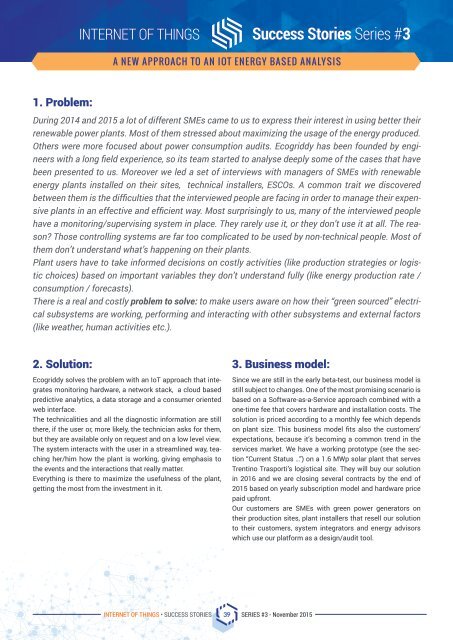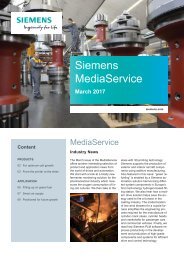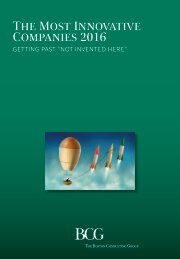Success Stories
VEZSJ
VEZSJ
Create successful ePaper yourself
Turn your PDF publications into a flip-book with our unique Google optimized e-Paper software.
Internet of Things <strong>Success</strong> <strong>Stories</strong> Series #3<br />
A new approach to an IoT energy based analysis<br />
1. Problem:<br />
During 2014 and 2015 a lot of different SMEs came to us to express their interest in using better their<br />
renewable power plants. Most of them stressed about maximizing the usage of the energy produced.<br />
Others were more focused about power consumption audits. Ecogriddy has been founded by engineers<br />
with a long field experience, so its team started to analyse deeply some of the cases that have<br />
been presented to us. Moreover we led a set of interviews with managers of SMEs with renewable<br />
energy plants installed on their sites, technical installers, ESCOs. A common trait we discovered<br />
between them is the difficulties that the interviewed people are facing in order to manage their expensive<br />
plants in an effective and efficient way. Most surprisingly to us, many of the interviewed people<br />
have a monitoring/supervising system in place. They rarely use it, or they don’t use it at all. The reason?<br />
Those controlling systems are far too complicated to be used by non-technical people. Most of<br />
them don’t understand what’s happening on their plants.<br />
Plant users have to take informed decisions on costly activities (like production strategies or logistic<br />
choices) based on important variables they don’t understand fully (like energy production rate /<br />
consumption / forecasts).<br />
There is a real and costly problem to solve: to make users aware on how their “green sourced” electrical<br />
subsystems are working, performing and interacting with other subsystems and external factors<br />
(like weather, human activities etc.).<br />
2. Solution:<br />
Ecogriddy solves the problem with an IoT approach that integrates<br />
monitoring hardware, a network stack, a cloud based<br />
predictive analytics, a data storage and a consumer oriented<br />
web interface.<br />
The technicalities and all the diagnostic information are still<br />
there, if the user or, more likely, the technician asks for them,<br />
but they are available only on request and on a low level view.<br />
The system interacts with the user in a streamlined way, teaching<br />
her/him how the plant is working, giving emphasis to<br />
the events and the interactions that really matter.<br />
Everything is there to maximize the usefulness of the plant,<br />
getting the most from the investment in it.<br />
3. Business model:<br />
Since we are still in the early beta-test, our business model is<br />
still subject to changes. One of the most promising scenario is<br />
based on a Software-as-a-Service approach combined with a<br />
one-time fee that covers hardware and installation costs. The<br />
solution is priced according to a monthly fee which depends<br />
on plant size. This business model fits also the customers’<br />
expectations, because it’s becoming a common trend in the<br />
services market. We have a working prototype (see the section<br />
“Current Status …”) on a 1.6 MWp solar plant that serves<br />
Trentino Trasporti’s logistical site. They will buy our solution<br />
in 2016 and we are closing several contracts by the end of<br />
2015 based on yearly subscription model and hardware price<br />
paid upfront.<br />
Our customers are SMEs with green power generators on<br />
their production sites, plant installers that resell our solution<br />
to their customers, system integrators and energy advisors<br />
which use our platform as a design/audit tool.<br />
Internet of Things • <strong>Success</strong> <strong>Stories</strong> 39 SERIES #3 - November 2015









